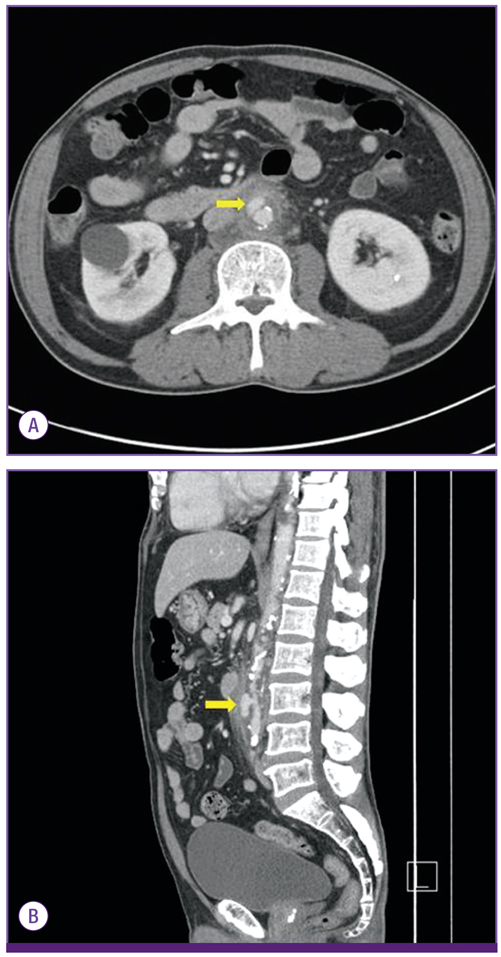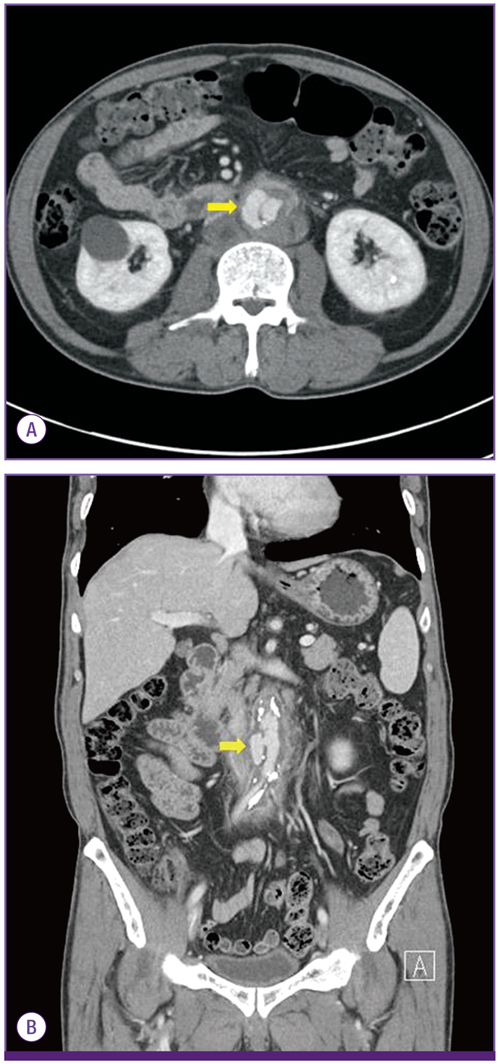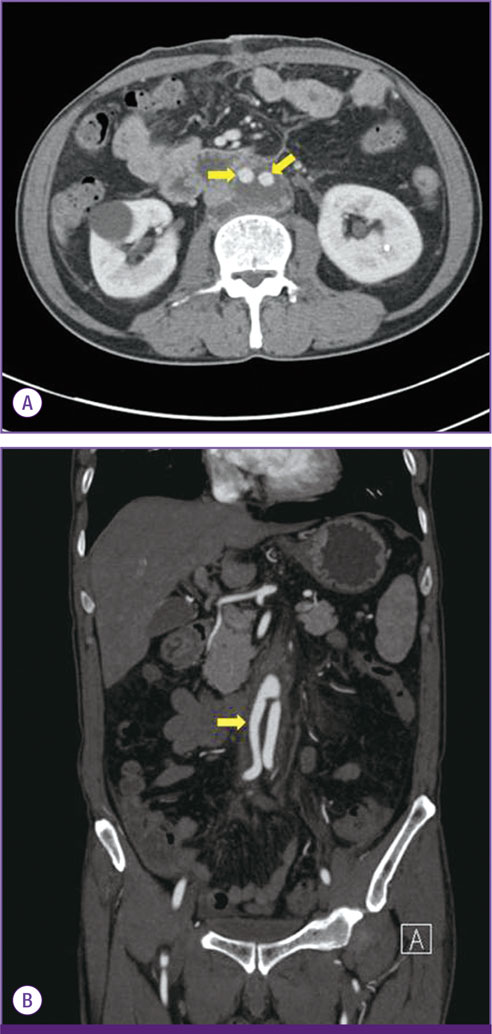Infect Chemother.
2014 Mar;46(1):54-58. 10.3947/ic.2014.46.1.54.
Mycotic Abdominal Aortic Aneurysm Caused by Bacteroides Thetaiotaomicron and Acinetobacter Lwoffii: The First Case in Korea
- Affiliations
-
- 1Division of Infectious Diseases, Department of Internal Medicine, Eulji University Hospital, Eulji University College of Medicine, Daejeon, Korea. yhj822@medimail.co.kr
- KMID: 2170462
- DOI: http://doi.org/10.3947/ic.2014.46.1.54
Abstract
- Mycotic aneurysms are uncommon, but are fatal without appropriate management. Previous reports have shown that anaerobes and gram-negative organisms are less common but more dangerous than other causative agents of mycotic aneurysm. We report the case of a 60-year-old man with poorly controlled diabetes mellitus and atherosclerosis in the aorta, and a 10-day of history of lower abdominal pain and fever. This man was diagnosed with an uncommon abdominal aorta mycotic aneurysm caused by Bacteroides thetaiotaomicron and Acinetobacter lwoffii. The aneurysm was successfully treated with antibiotics therapy and aorto-bi-external iliac artery bypass with debridement of the infected aortic wall. We present this case together with a review of the relevant literature.
MeSH Terms
Figure
Reference
-
1. Lopes RJ, Almeida J, Dias PJ, Pinho P, Maciel MJ. Infectious thoracic aortitis: a literature review. Clin Cardiol. 2009; 32:488–490.
Article2. Gornik HL, Creager MA. Aortitis. Circulation. 2008; 117:3039–3051.
Article3. Malouf JF, Chandrasekaran K, Orszulak TA. Mycotic aneurysms of the thoracic aorta: a diagnostic challenge. Am J Med. 2003; 115:489–496.
Article4. Müller BT, Wegener OR, Grabitz K, Pillny M, Thomas L, Sandmann W. Mycotic aneurysms of the thoracic and abdominal aorta and iliac arteries: experience with anatomic and extra-anatomic repair in 33 cases. J Vasc Surg. 2001; 33:106–113.
Article5. Johnson JR, Ledgerwood AM, Lucas CE. Mycotic aneurysm. New concepts in therapy. Arch Surg. 1983; 118:577.6. Maeda H, Umezawa H, Goshima M, et al. Primary infected abdominal aortic aneurysm: surgical procedures, early mortality rates, and a survey of the prevalence of infectious organisms over a 30-year period. Surg Today. 2011; 41:346.
Article7. Johansen K, Devin J. Mycotic aortic aneurysms: a reappraisal. Arch Surg. 1983; 118:583–588.8. Gomes MN, Choyke PL. Infected aortic aneurysms: CT diagnosis. J Cardiovasc Surg (Torino). 1992; 33:684–689.9. Lee HL, Liu KH, Yang YJ, Kan CD. Bacteroides fragilis aortic arch pseudoaneurysm: case report with review. J Cardiothorac Surg. 2008; 3:29.10. Jarrett F, Darling RC, Mundth ED, Austen WG. Experience with infected aneurysms of the abdominal aorta. Arch Surg. 1975; 110:1281–1286.
Article11. Miragliotta G, Del Gaudio T, Tajani E, Mosca A. Bacteroides thetaiotaomicron in posthysterectomy infection. Anaerobe. 2006; 12:276–278.
Article12. Rathinavelu S, Zavros Y, Merchant JL. Acinetobacter lwoffii infection and gastritis. Microbes Infect. 2003; 5:651–657.13. Weinstein MP. Blood culture contamination: persisting problems and partial progress. J Clin Microbiol. 2003; 41:2275–2278.
Article14. Goldstein EJ. Anaerobic bacteremia. Clin Infect Dis. 1996; 23:Suppl 1. S97–S101.
Article15. Kan CD, Lee HL, Yang YJ. Outcome after endovascular stent graft treatment for mycotic aortic aneurysm: a systematic review. J Vasc Surg. 2007; 46:906–912.
Article
- Full Text Links
- Actions
-
Cited
- CITED
-
- Close
- Share
- Similar articles
-
- Mycotic Aneurysm of Abdominal Aorta Causing the Right Renal Arterial Stenosis: Case Report
- Septic Arthritis Caused by Bacteroides thetaiotaomicron Bacteremia in a Patient with Multiple Myeloma
- Mycotic Aneurysm of the Left Subclavian Artery Presenting as Mediastinal Abscess: Case Report
- Infected Thoracic Aortic Aneurysm Concurrent with Endophthalmitis by Candida albicans: a Case Report
- Primary Aorto-Duodenal Fistula in Salmonella Mycotic Aortic Aneurysm: A Case Report




